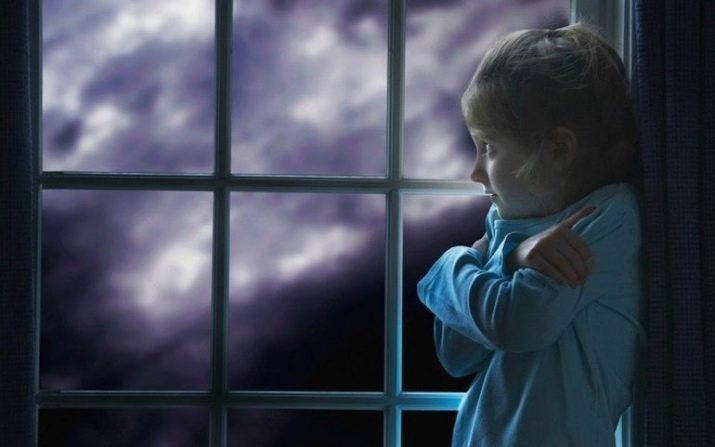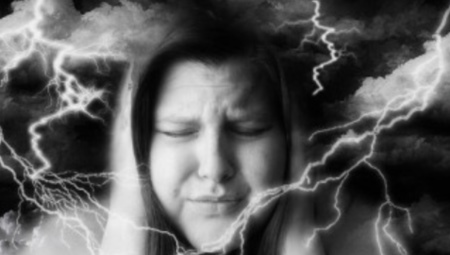Everyone has ever had an inexplicable sense of anxiety as a thunderstorm approached. Some greatly exaggerate its danger, and then fear gradually develops into a phobia. To begin treatment, it is necessary to understand the characteristics of the pathology and the causes of its occurrence.

What it is?
Fear of a thunderstorm from a sense of self-preservation is inherent in many people. But it happens that fear of lightning and thunder leads to anxiety disorder. A person experiences panic horror and loses his temper. He wants to hide, hide in the farthest corner. Such pathological fear of a thunderstorm called brontophobia.
In another way it is called keraunophobia.

These painful manifestations are affected by people of all ages. In some, brontophobia can be closely intertwined with other phobias:
- astrapophobia - horror arising from a sharp flash cutting through the clouds;
- tonitrophobia - a panic fear of thunder;
- ombrophobia - fear of falling out of the rain due to contact with drops or torrential streams;
- ligrophobia - fear of any strong and sharp threatening sounds, in this case, the thunder;
- acoustic phobia, phonophobia - fear of loud sounds.

Causes of occurrence
The reasons may lie in the beliefs, genetics or psychological trauma associated with this natural phenomenon.
- Someone perceives a thunderstorm as God's anger and heavenly punishment. Popular beliefs say that lightning strikes a person mired in sins.
- Fear can be transmitted at the genetic level. People have a tendency to hide from the weather, thereby protecting themselves.
- Feeling of our own vulnerability to the power of nature, irrational fear of a person arises before the inability to predict the consequences of an not entirely ordinary natural phenomenon. A person experiences all-consuming horror at the sight of dark clouds foreshadowing the approach of a thunderstorm.
- Some are afraid of ball lightning. There is evidence of the chaotic movement of mysterious fireballs, their ability to penetrate into a home through an open window and take the life of a person who is accidentally caught there.
- Impressive natures are afraid to fall victim to lightning. They heard about the people who died and suffered from the disaster, who, by the will of fate, ended up in the wrong place.
- Negatively affects watching news and movies, the plot of which is built on the destructive actions of various natural phenomena.
- Negative personal experience may be associated with lightning striking a building and igniting a building. It is possible that a person had to experience fear due to unexpectedly started lightning strikes during his stay in the forest.
- Children often take on parental anxiety and they are also afraid when a thundercloud appears.
- Animal lovers give in to anxiety seeing how their pets when approaching a thunderstorm fearfully clog into secluded corners.

Symptoms
People with bronophobia may have specific symptoms.
- They experience insurmountable horror at the sight of outlets, mistakenly believing that lightning through them can kill a person. Become afraid of any contact with household appliances. Do not touch metal objects.
- Some on the threshold of a thunderstorm there is a growing fear of being in an open area, as well as a fear of staying in a strange house. Frightened people often close their eyes and ears with their hands.
- In severe cases of brontophobia they behave incredibly strange: they build shelters from thunderstorms and bunkers, acquire a private house with an underground in which you can hide for the period of a thunderstorm. They are afraid to leave the house. If a thunderstorm catches them on the street, they panic and fall into hysteria.
- Future experiences push a person to a thorough study of the forecast of weather forecasters. Brontophobe does not miss a single television program with weather reports, scrupulously scans all meteorological sites, tries to observe the behavior of animals and not to forget about folk signs.

Physiological symptoms:
- cramping in the stomach;
- chills;
- tremor;
- tachycardia;
- decrease in body temperature;
- migraine;
- lack of oxygen;
- rapid breathing;
- increased sweating.


After the end of the thunderstorm, the symptoms disappear without a trace until the next case.
Treatment methods
Parents need to make a lot of efforts to prevent childhood fear of a thunderstorm, to prevent it from developing into a phobia. Fears of the child can lead to severe mental disorders and stuttering. With all his appearance one should demonstrate calm. No need to scold and especially to shame the child. It is necessary to hug the baby, calm, support.
It is necessary to tell the little man about this unique natural phenomenon and tell where lightning and thunder come from. You should overcome the fear of thunder in a playful way. You can simulate a strong roar with the help of covers from pots, bursting balloons. In this case, you have to laugh merrily.
Fairytale therapy is effective. She teaches children to respond appropriately to the sounds of thunder. During a thunderstorm, you can play with your baby in his favorite games.

A qualified specialist can carry out a full-fledged diagnosis and distinguish the usual fear of bad weather from abnormal fear. Assessment of the level of anxiety is performed on a Zang or Beck scale. If necessary, the mental state of a person is determined by other methods.
Cases when a person can overcome a phobia on his own. For this, during a thunderstorm it is necessary to create comfortable conditions for yourself, switch to your favorite things.You can listen to loud music, watch movies, do relaxing breathing exercises and some physical exercises. A soothing bath, herbal tea, motherwort, and tincture of valerian help well.
Tightly closed curtains give a person confidence in their own safety. It is advisable to be close to loved ones who always provide the necessary support.

When the situation gets out of control, you need to seek help from a specialist.
The therapist will help identify the cause of the phobia, advise and prescribe a comprehensive treatment. He can recommend medication. Antidepressants prevent the onset of severe depression. Tranquilizers eliminate vegetative and behavioral symptoms of panic, eliminate nervous tension, stop the manifestation of fear.
With hysterical syndrome, usually prescribed antipsychotic drugs. Additionally, general strengthening therapy is performed.
This phobia lends itself well to psychocorrection. Individual psychotherapy is based on identifying the causes of the disease and developing constructive ways to overcome this situation. Training courses in group classes contribute to the acquisition of full self-control skills during a thunderstorm.

Hypnotic sessions are helpful. A person is immersed in a trance for a while. Terrible thoughts are forced out of consciousness.
There is a conviction: a thunderstorm does not always promise terrible consequences. This method is suitable for people who tolerate hypnosis. Hypnologist helps to adjust the psyche.
Towards the end of the course of hypnosis, the fear of lightning and thunder dissipates, the phobia is supplanted by positive thoughts:
- there is no sharp reaction to the approach of a thunderstorm;
- a clear understanding comes that lightning strikes benefit nature, and there is nothing to worry about in thunder;
- mental state is gradually restored;
- the perception of a thunderstorm as a frightening phenomenon disappears;
- there is a release from fear.

Elemental knowledge helps to survive a thunderstorm morally. You should not approach open water bodies, you need to stay away from tall trees and power lines, you must turn off your mobile phone.
Once in a completely open area, a person should find a depression, kneel down and lie face down, clutching the back of his head with his hands.
On how to get rid of a child’s fear of a thunderstorm, see below.










